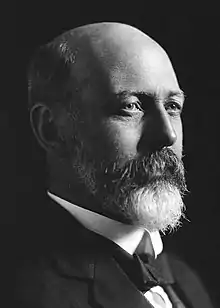1913 in Australia
The following lists events that happened during 1913 in Australia.
| 1913 in Australia | |
|---|---|
| Monarch | George V |
| Governor-General | Thomas Denman, 3rd Baron Denman |
| Prime minister | Andrew Fisher, then Joseph Cook |
| Population | 4,820,172 |
| Elections | Federal, New South Wales, Tasmania |
| |||||
| Decades: |
| ||||
|---|---|---|---|---|---|
| See also: | |||||
Incumbents
- Monarch – George V
- Governor-General – Thomas Denman, 3rd Baron Denman
- Prime Minister – Andrew Fisher (until 24 June), then Joseph Cook
- Chief Justice – Samuel Griffith
State premiers
- Premier of New South Wales – James McGowen (until 29 June), then William Holman
- Premier of Queensland – Digby Denham
- Premier of South Australia – Archibald Peake
- Premier of Tasmania – Albert Solomon
- Premier of Victoria – William Watt (until 9 December), then George Elmslie
- Premier of Western Australia – John Scaddan
State governors
- Governor of New South Wales – Frederic Thesiger, 3rd Baron Chelmsford (until 11 March), then Gerald Strickland (from 14 March)
- Governor of Queensland – William MacGregor
- Governor of South Australia – Day Bosanquet
- Governor of Tasmania – Harry Barron (until 10 March), then William Ellison-Macartney (from 4 June)
- Governor of Victoria – John Fuller
- Governor of Western Australia – Gerald Strickland (until 4 March), then Harry Barron (from 17 March)
Events
- 2 January — Australian philately proper begins in early 1913 with the Kangaroo and Map series of stamps, featuring a kangaroo standing on a map of Australia, and inscribed "AUSTRALIA POSTAGE".
- 12 March — Canberra is named by Gertrude Denman
- 1 May — The first national banknotes were introduced in denominations of 10 shillings, and 1, 5, and 10 pounds.
- 31 May — 1913 Australian referendum contained six questions: Trade and Commerce, Corporations, Industrial Matters, Trusts, Monopolies, Railway Disputes. None of these were carried.
- 21 June — HMAS Australia, commissioned at Portsmouth and sailed to Australia to become the Australian flagship.
- 1 to 31 August — With an average rainfall of 0.24 millimetres or 0.0094 inches, this is the driest area-averaged month over Queensland since at least 1900.[1]
- Royal Commission appointed to inquire into certain charges against Henry Chinn; Chinn was supervising engineer for the transcontinental railway in Western Australia.
- Royal Commission on Northern Territory railways and ports
- Royal Commission on powellised timber
- Golden Fleece Company established by HC Sleigh; acquired by Caltex in 1981
- The Workers' Educational Association founded; it is Australia's largest non-government adult community education organisation.
- From 1859 until 1913, a squadron of the Royal Navy was maintained in Australian waters.
- Norfolk Island Act 1913 meant that Norfolk Island became an Australia Territory under the authority of the Australian Commonwealth.
Science and technology
- Amalgamation took place between Marconi's Wireless Telegraph Co. Ltd and the Australian Wireless Company forming Amalgamated Wireless Australasia Limited.
- The first totalisator, an entirely mechanical system invented by the Australian George Julius of Julius Poole & Gibson Pty Ltd, was installed at Ellerslie Racecourse in New Zealand.
Arts and literature
Film
- Moondyne
- Australia Calls, Raymond Longford's last film for Cozens Spencer was released.
- Frank Hurley's actuality film, The Home of the Blizzard, about the Douglas Mawson expedition to Antarctica, was released.
Sport
- The 1913 VFL (now AFL) Premiership was won by Fitzroy
- The 1913 NSWRFL Premiership is won by Eastern Suburbs for the third year in a row.
- Posinatus wins the Melbourne Cup
- South Australia wins the 1912–13 Sheffield Shield
- The Australian cricket team toured USA and Canada in June to August, playing five matches, four in Philadelphia and one in Toronto.
Births
- 24 January – Ray Stehr, rugby league footballer (d. 1983)
- 11 February – Clyde Cameron, Whitlam government minister (d. 2008)
- 20 February – Dame Mary Durack, author and historian (d. 1994)
- 5 March – Darby Munro, jockey (d. 1966)
- 19 March – Smoky Dawson, country music performer (d. 2008)
- 3 April – William Refshauge, soldier and public health administrator (d. 2009)
- 4 April – Dave Brown, rugby league footballer (d. 1974)
- 20 June – David McNicol, public servant and diplomat (d. 2001)
- 2 August – Nancy Phelan, writer (d. 2008)
- 14 August – Hector Crawford, Australian television producer (d. 1991)
- 6 September – Ken Kennedy, speed skater and ice hockey player (d. 1985)
- 2 October – Dame Roma Mitchell, 31st Governor of South Australia (d. 2000)
- 30 October – Edgar Britt, jockey (d. 2017)
- 30 December – Elyne Mitchell, author (d. 2002)
Deaths
- 3 January – Garnet Walch, writer, journalist and publisher (b. 1843)
- 4 February – James Styles, Victorian politician (born in the United Kingdom) (b. 1841)
- 18 February – George Lewis Becke, trader and writer (b. 1855)
- 4 June – Ambrose Dyson, illustrator and political cartoonist (b. 1876)
- 6 July – J. C. Williamson, actor (born in the United States and died in France) (b. 1844)
- 20 July – Joseph Vardon, South Australian politician and printer (b. 1843)
- 3 August – Sir William Lyne, 13th Premier of New South Wales (b. 1844)[2]
- 25 August – William Knox, Victorian politician and businessman (died in the United Kingdom) (b. 1850)
- 12 November – Sir John George Davies, Tasmanian politician, newspaper proprietor and cricketer (b. 1846)
- 25 November – Charlie Frazer – Western Australian politician (b. 1880)
References
- "Sorted rainfall over Queensland for all months". Australian Bureau of Meteorology.
- Chris Cunneen (1986). Geoff Serle (ed.). Lyne, Sir William John (1844–1913). Australian Dictionary of Biography. Vol. 10. Melbourne University Press. Retrieved 3 January 2022.
This article is issued from Wikipedia. The text is licensed under Creative Commons - Attribution - Sharealike. Additional terms may apply for the media files.
.jpg.webp)

.jpg.webp)